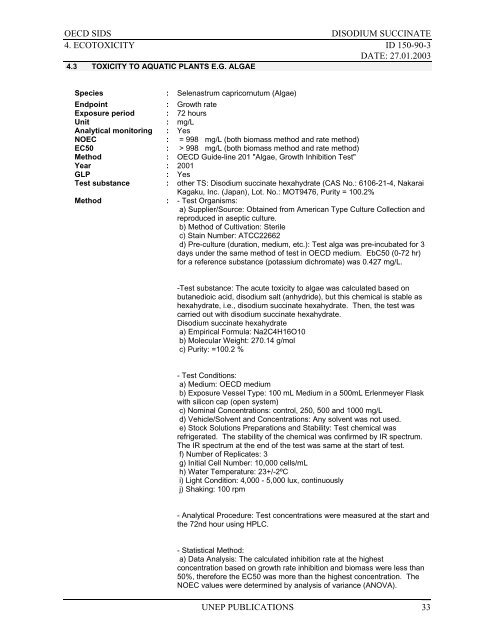DISODIUM SUCCINATE CAS N°: 150-90-3
DISODIUM SUCCINATE CAS N°: 150-90-3
DISODIUM SUCCINATE CAS N°: 150-90-3
Create successful ePaper yourself
Turn your PDF publications into a flip-book with our unique Google optimized e-Paper software.
OECD SIDS<br />
<strong>DISODIUM</strong> <strong>SUCCINATE</strong><br />
4. ECOTOXICITY ID <strong>150</strong>-<strong>90</strong>-3<br />
DATE: 27.01.2003<br />
4.3 TOXICITY TO AQUATIC PLANTS E.G. ALGAE<br />
Species : Selenastrum capricornutum (Algae)<br />
Endpoint : Growth rate<br />
Exposure period : 72 hours<br />
Unit : mg/L<br />
Analytical monitoring : Yes<br />
NOEC : = 998 mg/L (both biomass method and rate method)<br />
EC50 : > 998 mg/L (both biomass method and rate method)<br />
Method : OECD Guide-line 201 "Algae, Growth Inhibition Test"<br />
Year : 2001<br />
GLP : Yes<br />
Test substance : other TS: Disodium succinate hexahydrate (<strong>CAS</strong> No.: 6106-21-4, Nakarai<br />
Kagaku, Inc. (Japan), Lot. No.: MOT9476, Purity = 100.2%<br />
Method : - Test Organisms:<br />
a) Supplier/Source: Obtained from American Type Culture Collection and<br />
reproduced in aseptic culture.<br />
b) Method of Cultivation: Sterile<br />
c) Stain Number: ATCC22662<br />
d) Pre-culture (duration, medium, etc.): Test alga was pre-incubated for 3<br />
days under the same method of test in OECD medium. EbC50 (0-72 hr)<br />
for a reference substance (potassium dichromate) was 0.427 mg/L.<br />
-Test substance: The acute toxicity to algae was calculated based on<br />
butanedioic acid, disodium salt (anhydride), but this chemical is stable as<br />
hexahydrate, i.e., disodium succinate hexahydrate. Then, the test was<br />
carried out with disodium succinate hexahydrate.<br />
Disodium succinate hexahydrate<br />
a) Empirical Formula: Na2C4H16O10<br />
b) Molecular Weight: 270.14 g/mol<br />
c) Purity: =100.2 %<br />
- Test Conditions:<br />
a) Medium: OECD medium<br />
b) Exposure Vessel Type: 100 mL Medium in a 500mL Erlenmeyer Flask<br />
with silicon cap (open system)<br />
c) Nominal Concentrations: control, 250, 500 and 1000 mg/L<br />
d) Vehicle/Solvent and Concentrations: Any solvent was not used.<br />
e) Stock Solutions Preparations and Stability: Test chemical was<br />
refrigerated. The stability of the chemical was confirmed by IR spectrum.<br />
The IR spectrum at the end of the test was same at the start of test.<br />
f) Number of Replicates: 3<br />
g) Initial Cell Number: 10,000 cells/mL<br />
h) Water Temperature: 23+/-2ºC<br />
i) Light Condition: 4,000 - 5,000 lux, continuously<br />
j) Shaking: 100 rpm<br />
- Analytical Procedure: Test concentrations were measured at the start and<br />
the 72nd hour using HPLC.<br />
- Statistical Method:<br />
a) Data Analysis: The calculated inhibition rate at the highest<br />
concentration based on growth rate inhibition and biomass were less than<br />
50%, therefore the EC50 was more than the highest concentration. The<br />
NOEC values were determined by analysis of variance (ANOVA).<br />
UNEP PUBLICATIONS 33
















